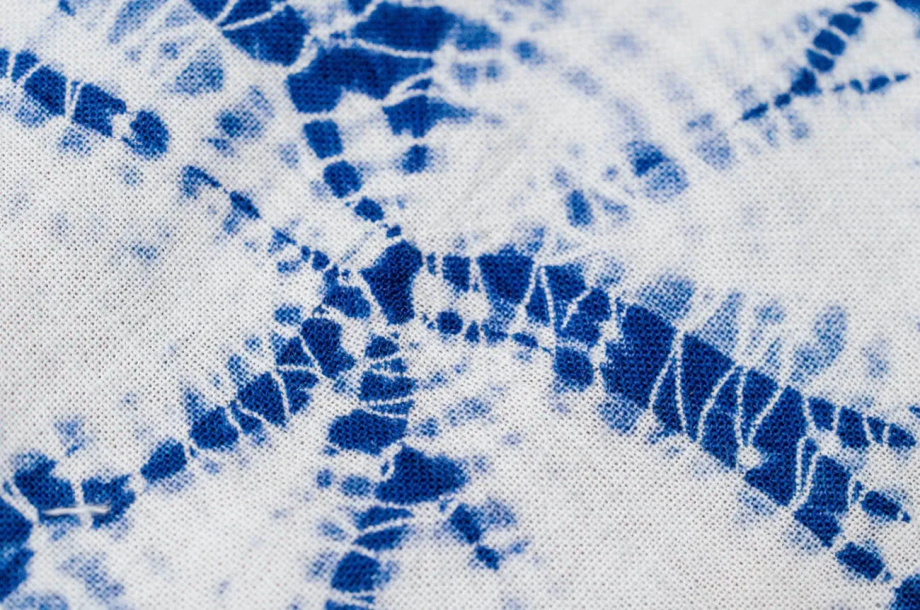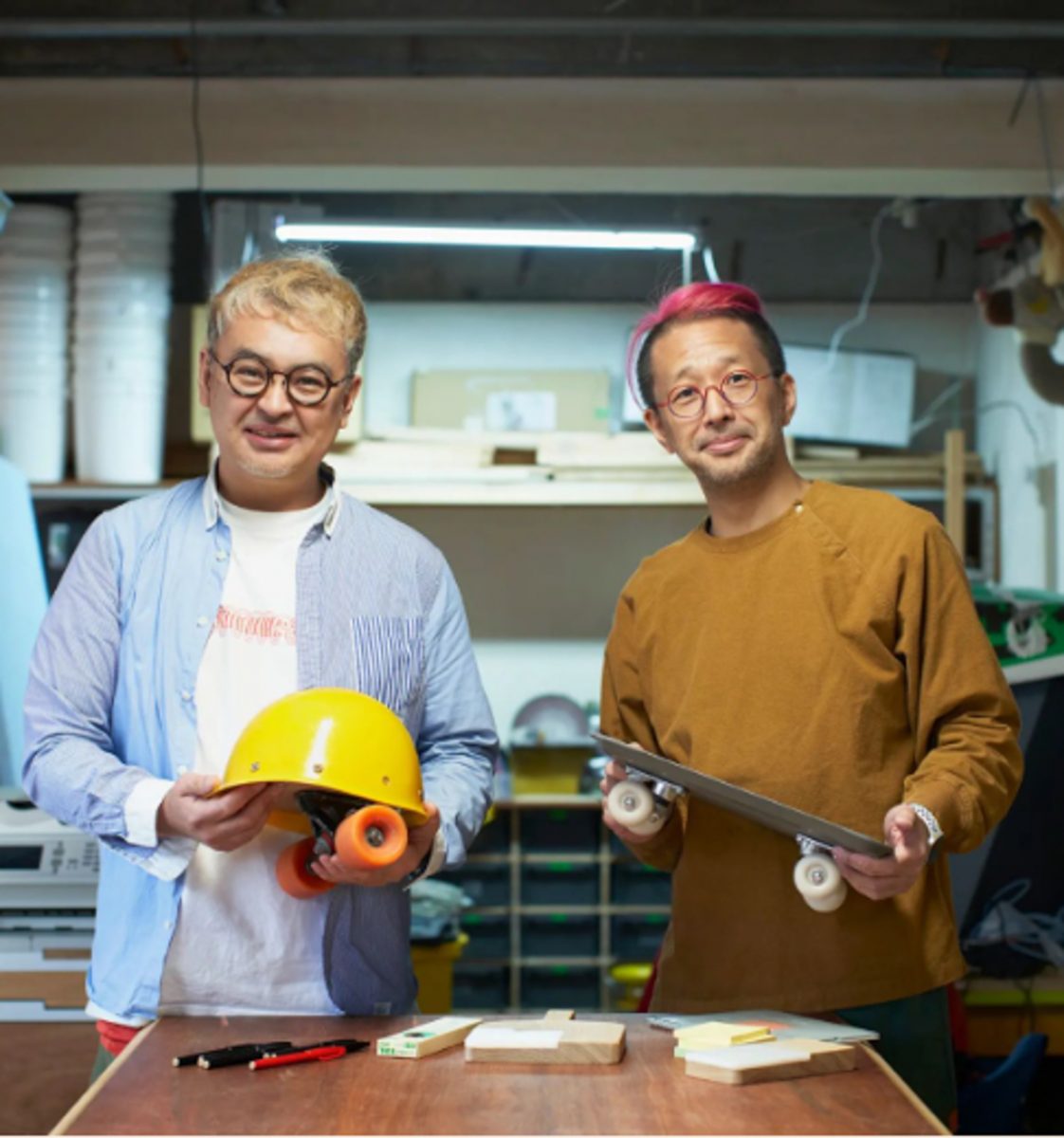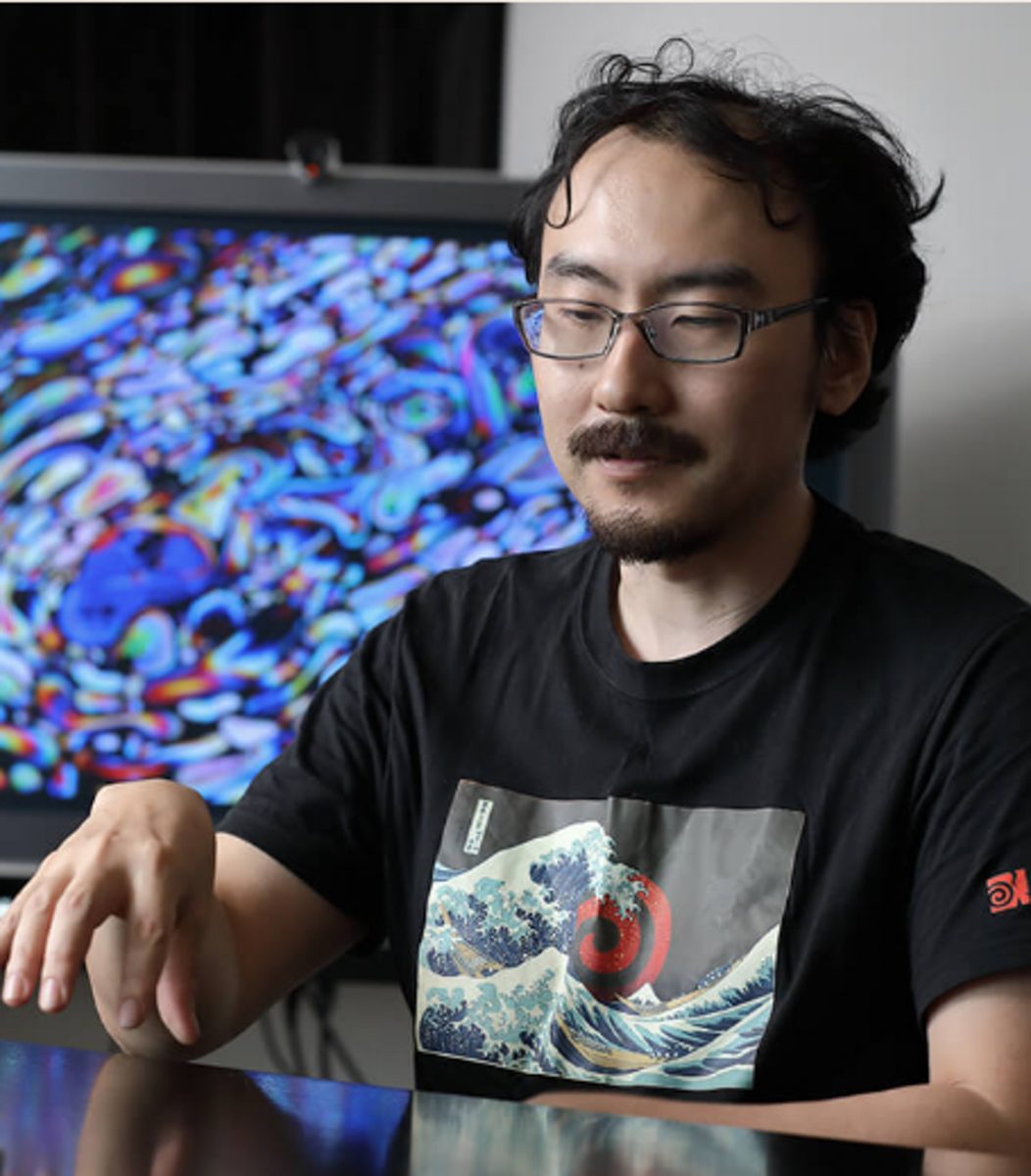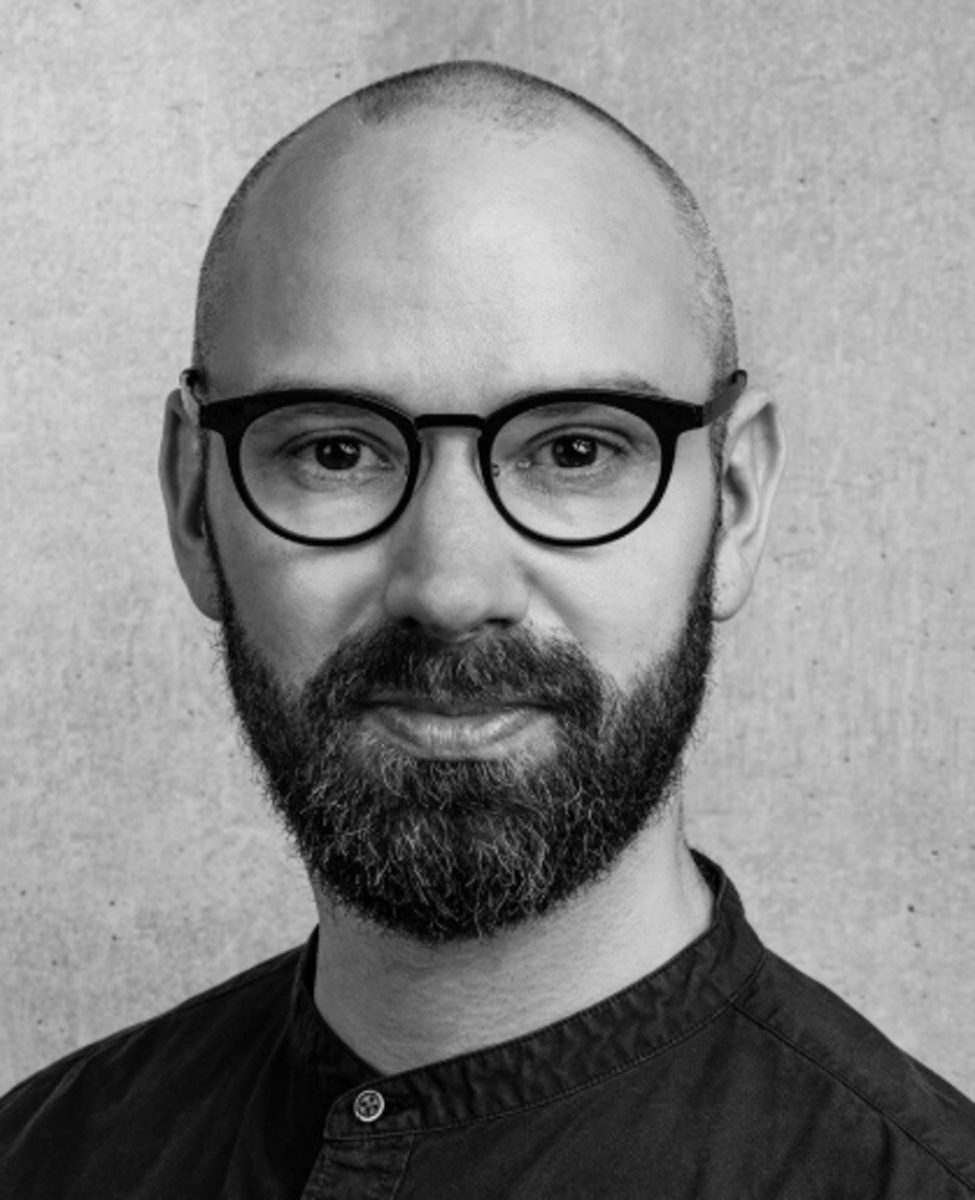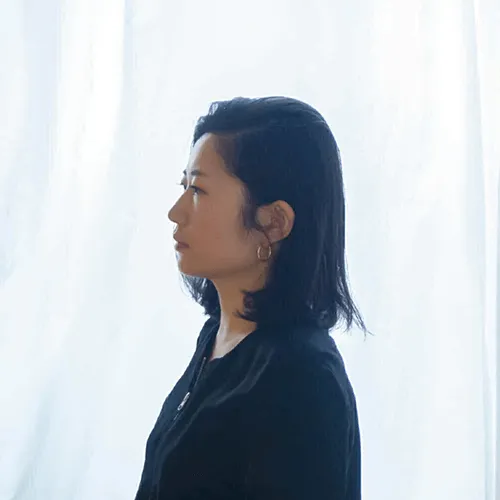Project Case
July 22, 2025
FabCafe Global Editorial Team
DENSO Corporation is a global automotive components manufacturer with advanced technologies and development expertise in a variety of systems and products, including those used in automotive manufacturing. As a leader in innovative mobility technologies and solutions, DENSO envisions a “A society where well-being circulates”, a future that caters for a variety of values and forms of happiness.
In 2023, FabCafe Tokyo, in collaboration with DENSO Corporation, launched the project TECHNO GRAPHICAL DATA ARCHIVE (TGDA) to digitally archive traditional techniques that are at risk of disappearing.
TGDA explores new possibilities for preserving and reapplying traditional craftsmanship in contemporary contexts by scanning and preserving the hand movements of master artisans. This article examines the value and future potential of the project.
Project Overview
TECHNO GRAPHICAL DATA ARCHIVE (TGDA) is a collaborative project between DENSO Corporation and FabCafe Tokyo. Focusing on the historic Tokaido region, the initiative aims to digitally archive traditional craftsmanship that is disappearing, and to rediscover its cultural and technological value.
Traditional cultures around the world are in steady decline due to factors such as natural disasters, war, climate change and falling populations. The field of traditional crafts, which relies heavily on human skill, is under increasing pressure from technological innovation driving automation and efficiency. In Japan, the aging population of traditional artisans is accelerating this trend further, with many skills and forms of knowledge passed down orally disappearing without ever being documented or preserved.
This project is based in the Tokaido region, which is historically renowned for its rich tradition of craftsmanship that has been passed down through the generations. The project’s mission is to digitally capture and archive the masterful techniques of traditional artisans on a data platform that is accessible from anywhere in the world. This will promote the preservation and transmission of local culture by making it accessible to a global audience.
TGDA was an initiative launched by DENSO in 2023. The company envisaged a future in which its technologies would contribute to society and expressed this vision in the form of a manga comic.
Titled ‘DENSO Future Story’, this comic portrayed scenarios that would be made possible by DENSO’s technological capabilities. It was published on a website and as a printed booklet. Rather than being limited to the automotive industry, in which DENSO has long excelled, the project explored how the company could create products and services that would lead to greater user happiness across a broader range of fields.
Learn more about “DENSO Future Story” (Japanese only)
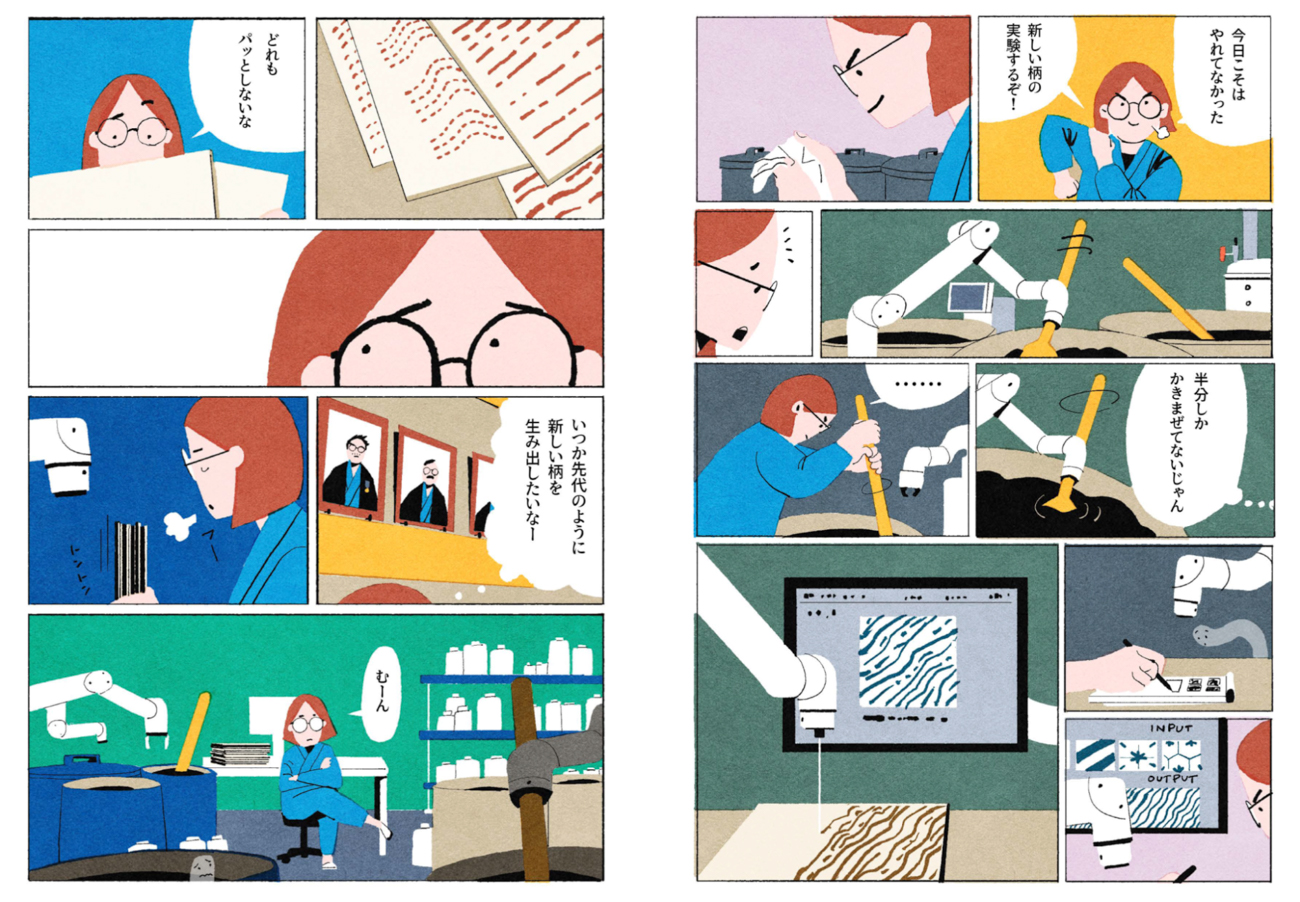
This manga by Kent IIDA features a craftswoman who specialises in Arimatsu shibori and collaborates with AI and robotics to develop new patterns. The story explores the creative process of combining human tradition with emerging technologies.
One of the stories, titled ‘Creative Share Platform’, is set in the world of traditional crafts and depicts a future in which humans and robotic arms work together. Rather than replacing human labour, the story portrays technology as a means to expand human potential.
The manga has received positive feedback from professionals in the manufacturing and craftsmanship industries.
It was precisely this envisioned future, where tradition and technology work in harmony, that inspired the launch of the TGDA project in the real world.
TGDA is a project that aims to promote traditional craft techniques through digital archiving. Its goal is to preserve and pass down the skills of master artisans, while also generating new collaborations between craftspeople and digital technologies, ensuring that the value of these skills is returned to the artisans themselves.
To achieve this, TGDA uses 3D scanning to capture the hand movements involved in traditional craft production, creating a detailed archive of these techniques. This data will be made accessible online in the future, enabling broader use and supporting the project’s mission of preserving, applying and reinvesting in the craft community.
DENSO and FabCafe conducted fieldwork in the Tokai region, an area with strong connections to both organisations, and began reaching out to artisans working along the historic Tokaido route. The project team made repeated visits to the area, engaging in dialogue with craftspeople and documenting their techniques using 3D scanning technology.
The project aims to promote the preservation and transmission of these techniques on a global scale by converting traditional craft skills into digital data and archiving them on an open-access platform. By sharing its mission and vision for the future, TGDA gradually gained the trust and collaboration of more and more artisans.
One of the project’s key collaborators was Kaei Hayakawa, a shibori restoration artist specialising in arashi shibori, a distinctive tie-dyeing technique passed down through the generations in Arimatsu Town, Nagoya. Hayakawa has long been dedicated to reviving traditional techniques that had disappeared, making him an ideal partner for the TGDA initiative to preserve and pass on endangered craftsmanship.
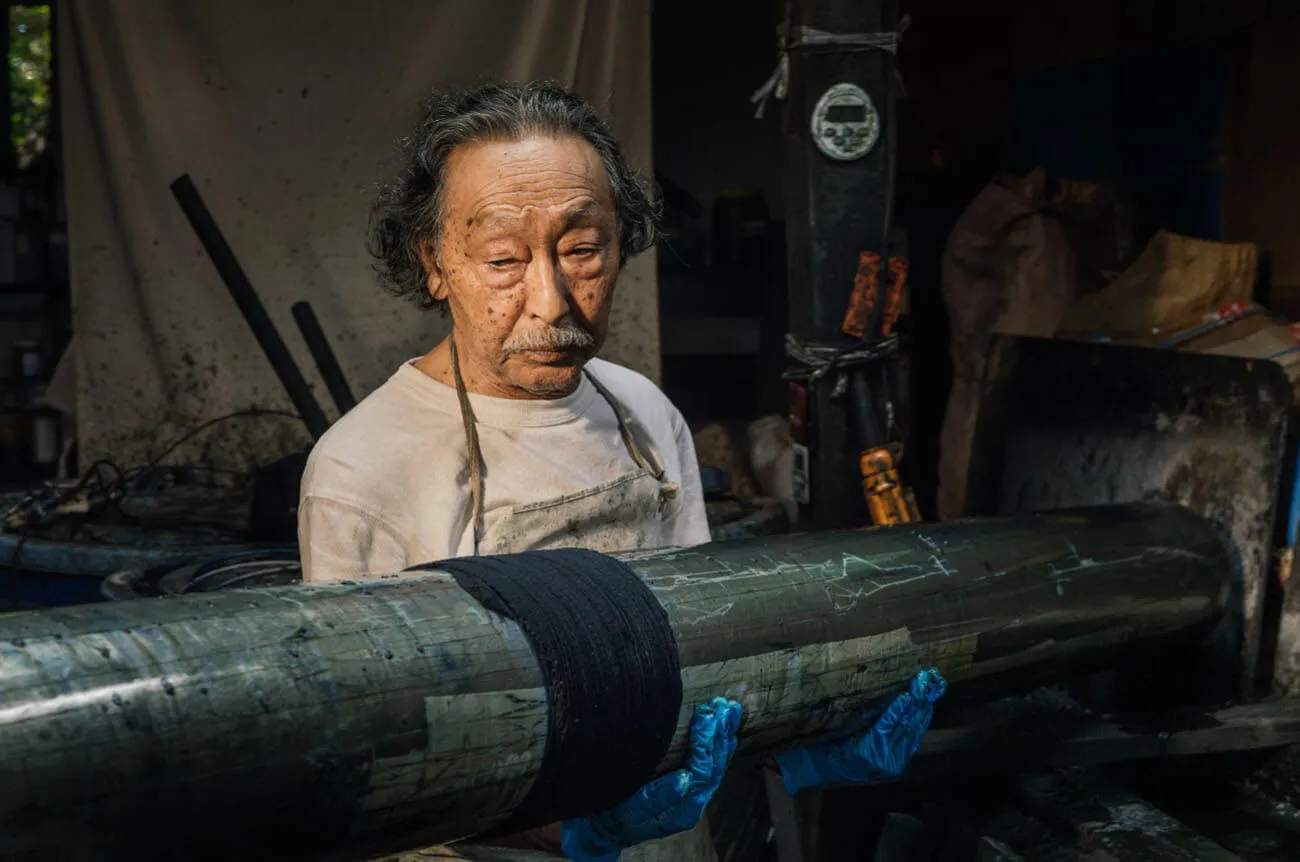
Photos: shot by Kusk
Hayakawa practises a technique known as Arashi Shibori, a form of tie-dyeing believed to have originated in the Arimatsu district (now part of Arimatsu Town in Nagoya City) around 1879. The process involves wrapping fabric around a long rod, binding it tightly with thread and compressing it before dyeing. This method produces dynamic, flowing patterns said to resemble rain and wind during a storm, hence the name ‘arashi’, which means ‘storm’ in Japanese.
At its peak, over 100 distinct Arashi Shibori techniques were said to exist, with each artisan developing and preserving their own unique variation.

However, due to the physically demanding nature of the work and the many years it took to master the technique, the practice of Arashi Shibori declined sharply. By the 1980s, the last known practitioner of the tradition had passed away and the technique was believed to have disappeared.
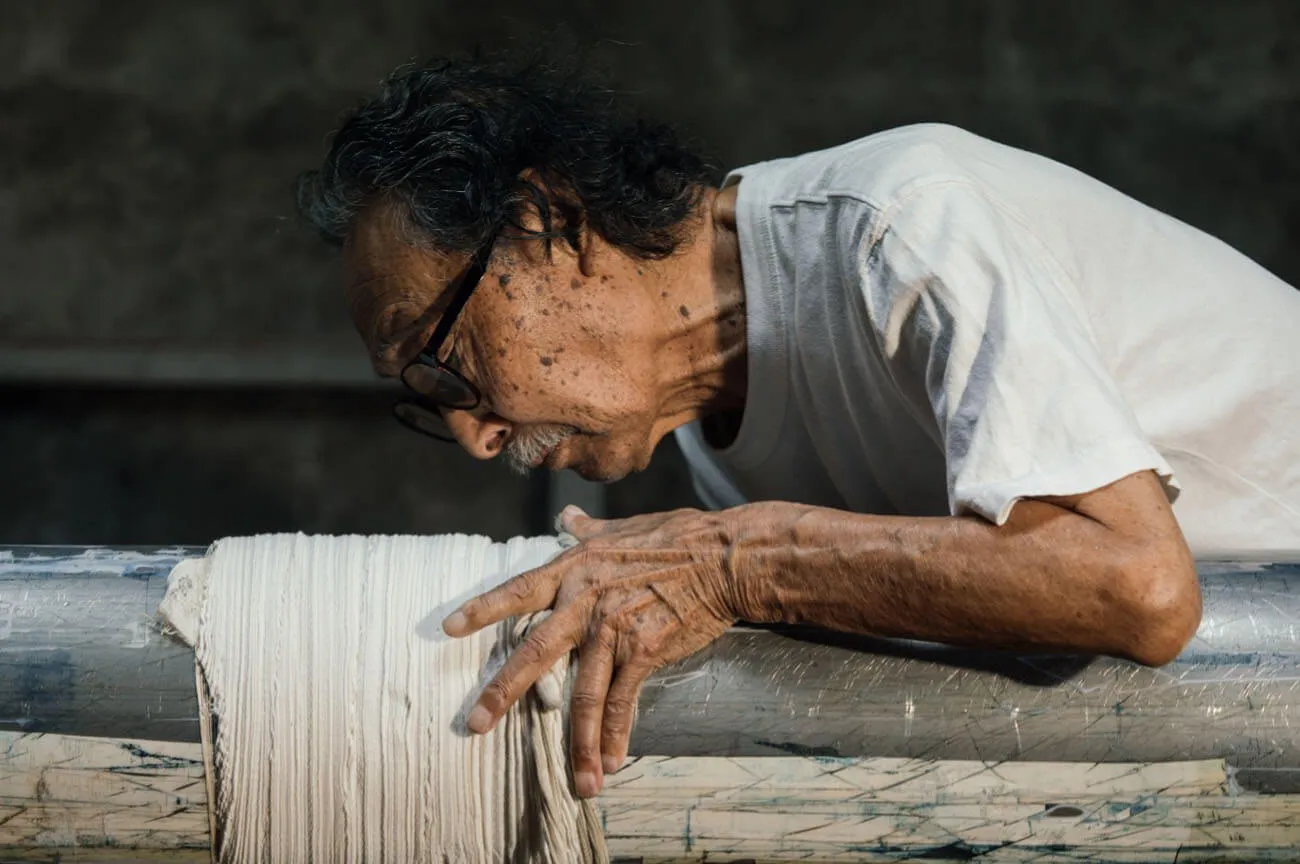
Kaei Hayakawa, born into a family with a long history of dyeing in Arimatsu and himself an active shibori artist, took it upon himself to carry on the spirit and skill of his predecessors. After years of experimentation and refinement, he developed his own version of the Arashi Shibori technique, breathing new life into the lost tradition.
So, what exactly did this project entail? Let’s take a look at it from the beginning. After being approached by DENSO, FabCafe organised the project into several phases. The journey so far can be broadly divided into two key phases.
In Phase 1, the team focused on researching traditional craftsmanship and built a prototype web platform to digitally archive the collected data. To explore how the future envisioned in the ‘DENSO Future Story’ could be realised, the team began by conducting field investigations and small-scale experiments.
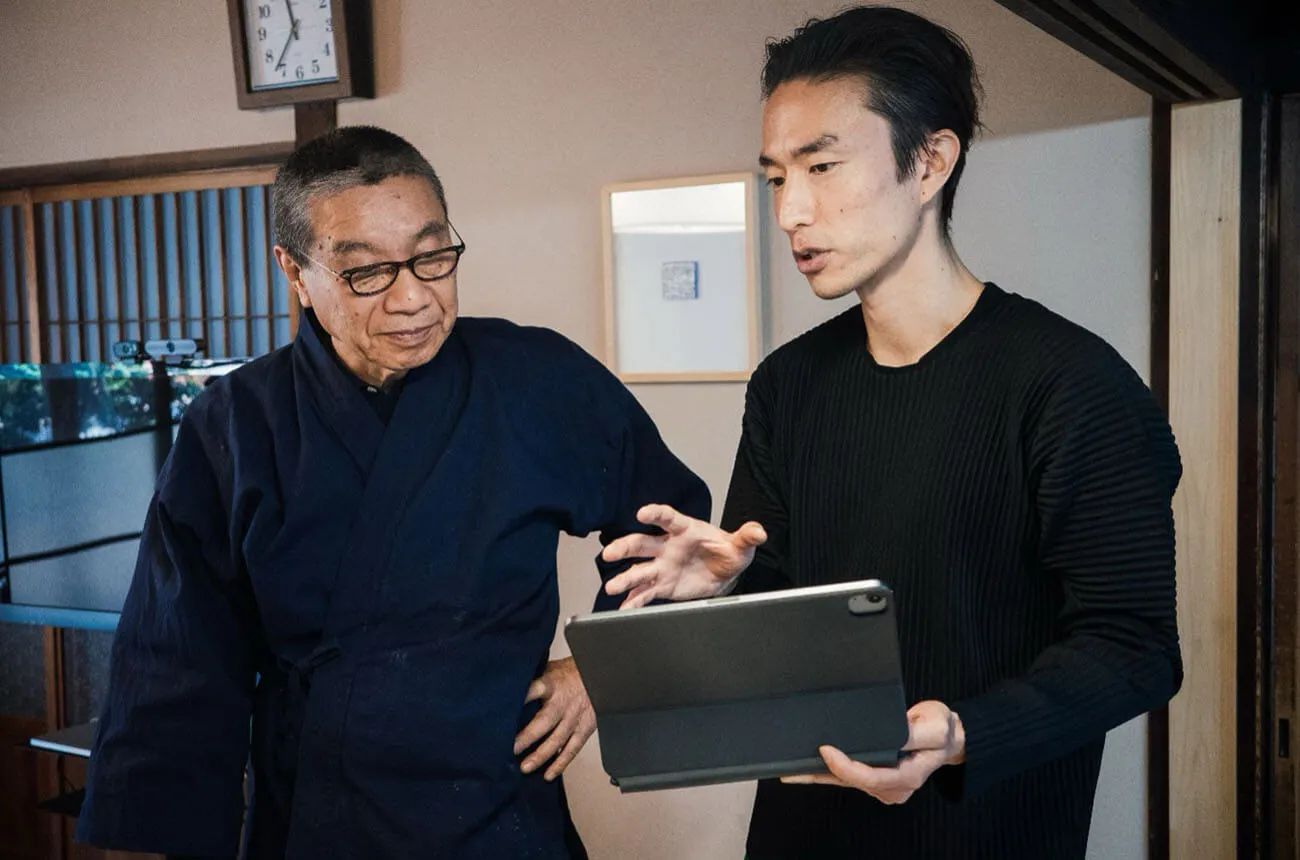
Hiroshi Murase (left in photo), fourth-generation chairman of Suzusan Co., Ltd., a company specializing in the production of Arimatsu-Narumi Shibori, who generously contributed to the scanning process.
Through interviews with artisans, the team gained an understanding of the current situation: many traditional crafts have no successors, and the industry itself is shrinking, making it increasingly difficult for artisans to earn a living. In response to these challenges, the TGDA team identified two key themes at the heart of the project.
How can we preserve traditional techniques that are disappearing?
What is needed to elevate the value of artisans’ skills?
These questions have guided the project’s direction ever since.
Bringing a bold and experimental project like this to life required collaboration with creators who possess strong technical expertise. Leveraging FabCafe’s creative network enabled the team to involve highly capable and imaginative creators from the outset. Their involvement helped to overcome technical challenges and shape the overall concept and prototypes.
The director-side team also comprised members with a solid understanding of technology and creative expression. This structure enabled rapid prototyping and testing in close collaboration with the creators, facilitating the refinement of ideas through hands-on experimentation.
In the second phase, the project expanded its research by engaging more artisans and conducting additional scans and interviews. Meanwhile, work on the design and development of the web platform progressed, bringing it closer to real-world implementation.
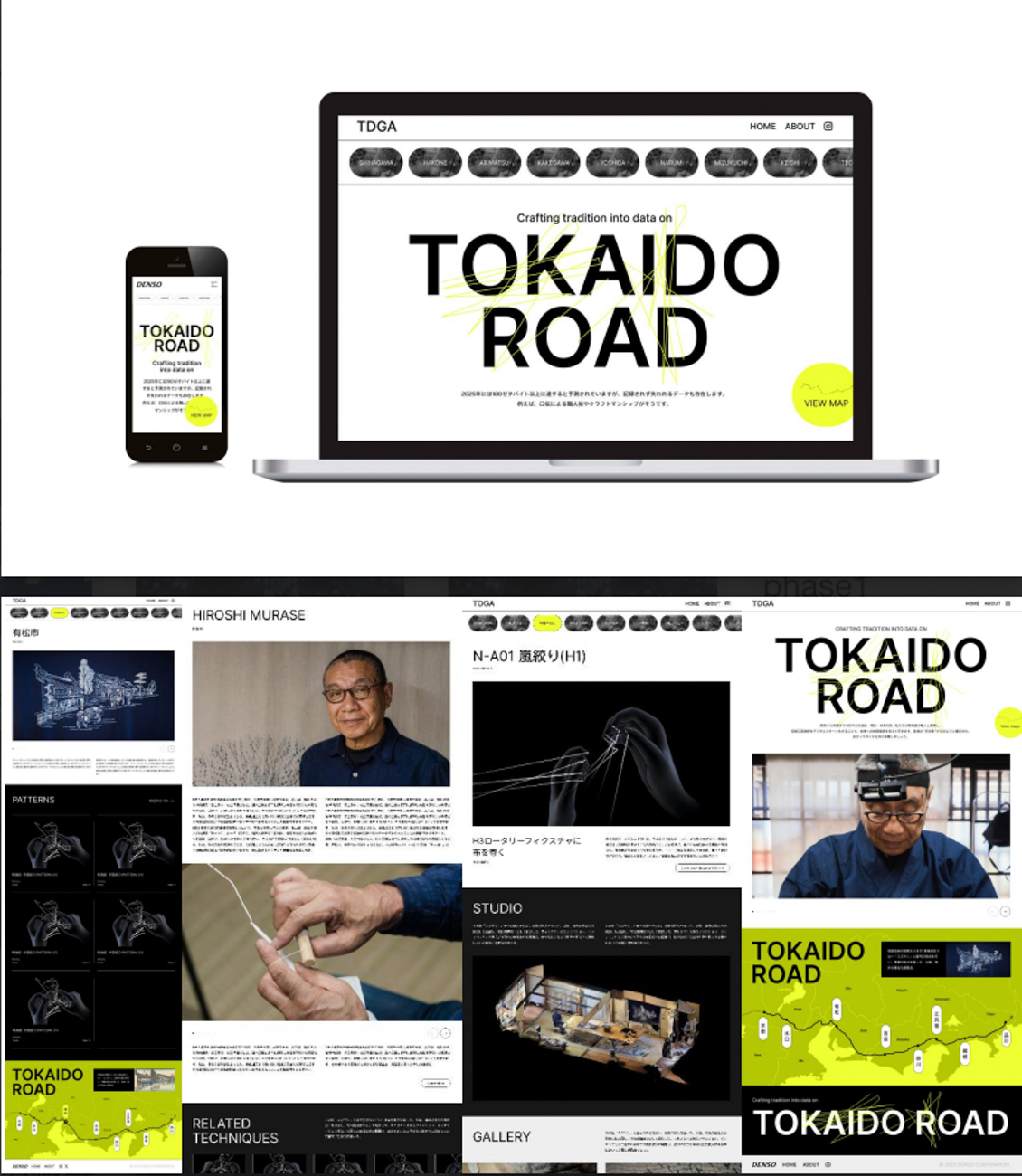
The TGDA project aims to preserve the possibility for future generations to engage with traditional crafts by scanning and digitally archiving the hand techniques of artisans. Throughout the project, a key principle has been to ensure that it creates mutual value, benefiting both the artisans and society.
By scanning human movements to recreate traditional skills, we can begin to understand the difference between what can only be done by human hands and what can only be achieved with the help of machines. This enables us to provide valuable feedback to the artisans themselves.
Reverse-engineering techniques from 3D scan data can reveal new insights into Arimatsu Shibori, techniques that are difficult for humans to replicate, or which artisans may not yet have discovered. Exposing artisans to such insights could spark new waves of creativity and lead to the development of entirely new methods.
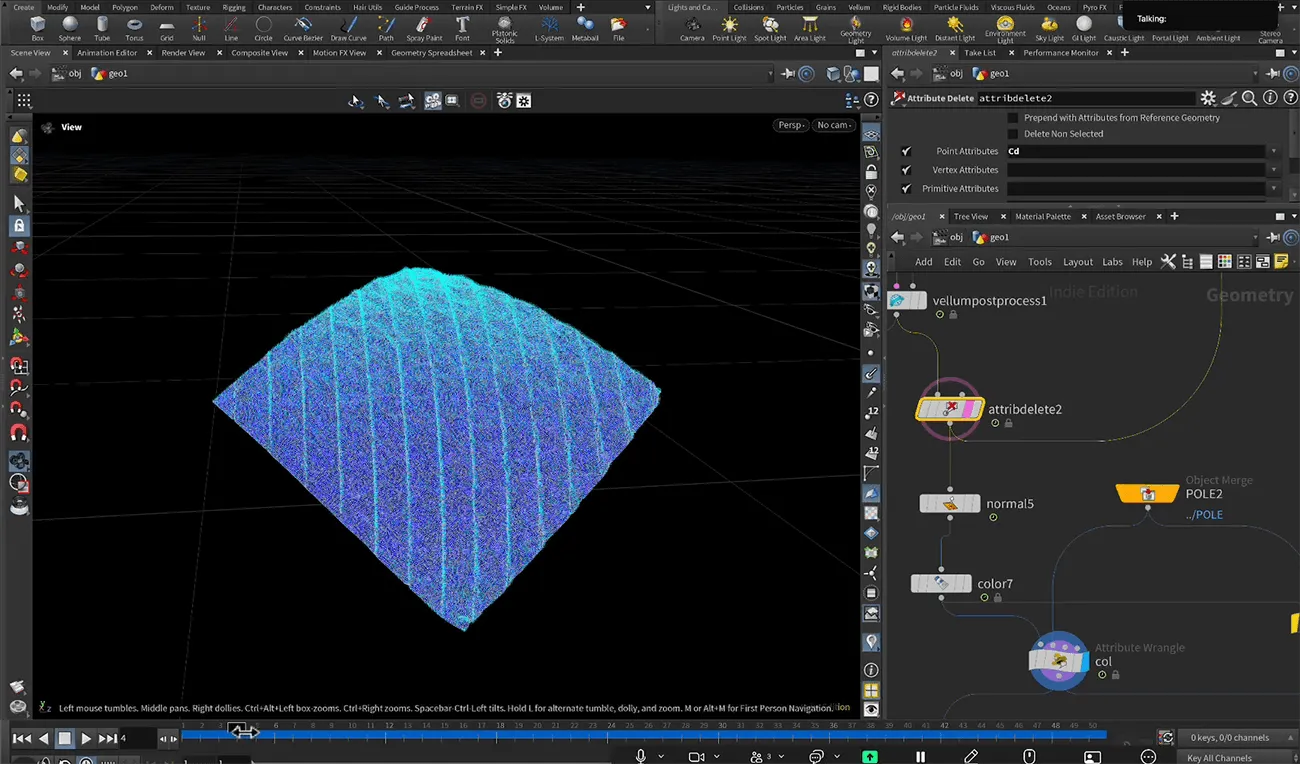
As well as providing insights into technique, this project could generate benefits for artisans, such as financial feedback and new relationships. By connecting craftspeople, who are often isolated, with the world through digital archives and making their work openly accessible, there is greater potential to link traditional skills with people eager to learn about or support them.
It may also become possible to compensate artisans directly, for example through the purchase of digital archives or payment for access and viewing rights.
The goal of this project is not only to preserve traditional techniques for future generations. Rather than treating the archive solely as a means of recording what is fading, our aim is to activate it as a living resource, creating a mutually beneficial relationship between artisans and society.
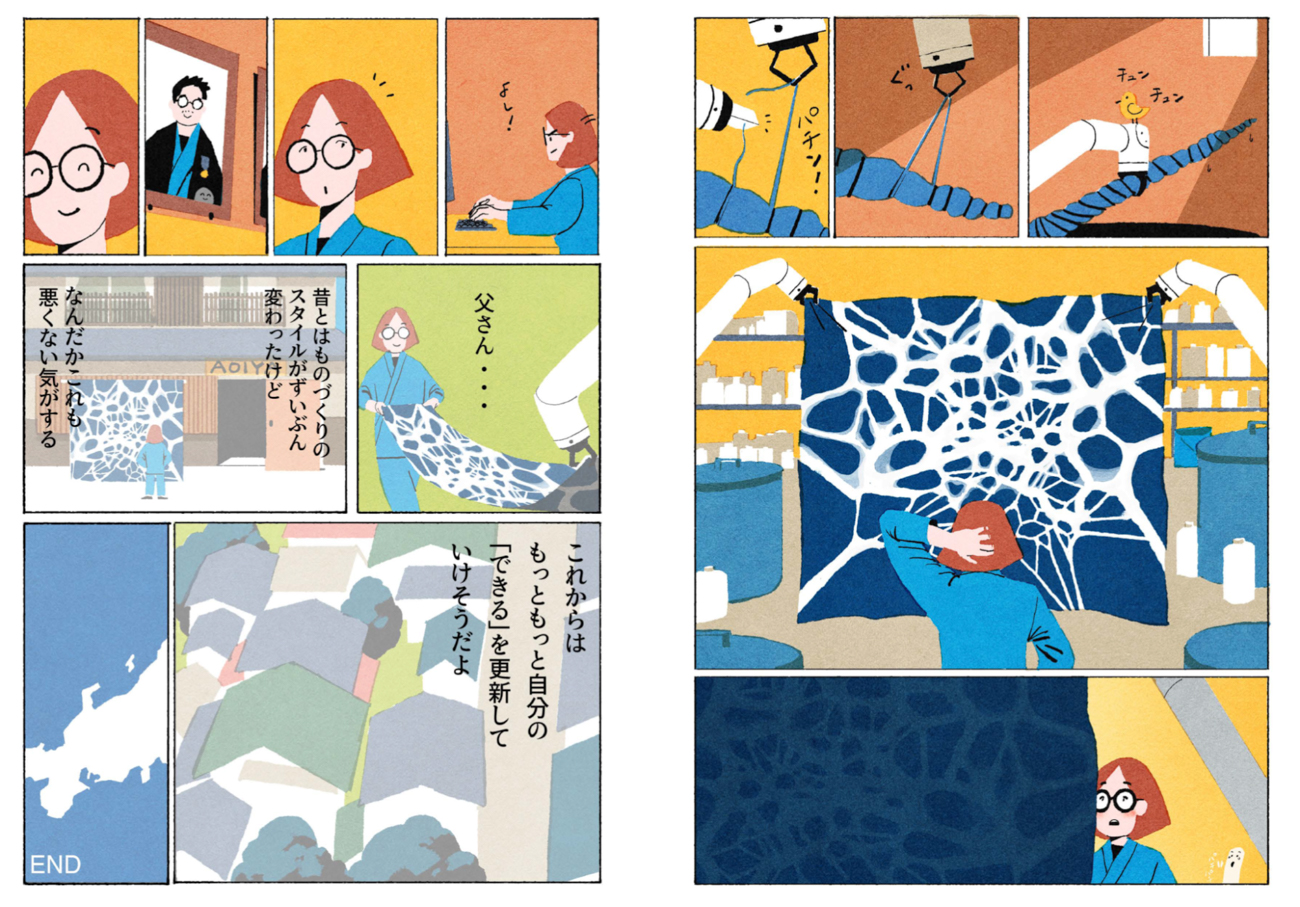
Each artisan involved in the project is also an artist, constantly pursuing new forms of expression in their daily practice. To support and inspire them, we are exploring ways to offer meaningful feedback, just as envisioned in the “DENSO Future Story”, that can contribute to their ongoing creative evolution.
Why did DENSO decide to take on a project like TGDA? Alongside its vision of creating a ‘Well-being Circulatory Society’, the company questioned the role of corporate technology.
Many small and medium-sized manufacturers with advanced technologies tend to take a technology-driven approach. Metrics such as ‘how fast’, ‘how light’, and ‘what functions it has’ often dominate their evaluation criteria. However, Yoshioka, an in-house artist from DENSO’s Design Division, emphasises the importance of a vision-driven mindset.
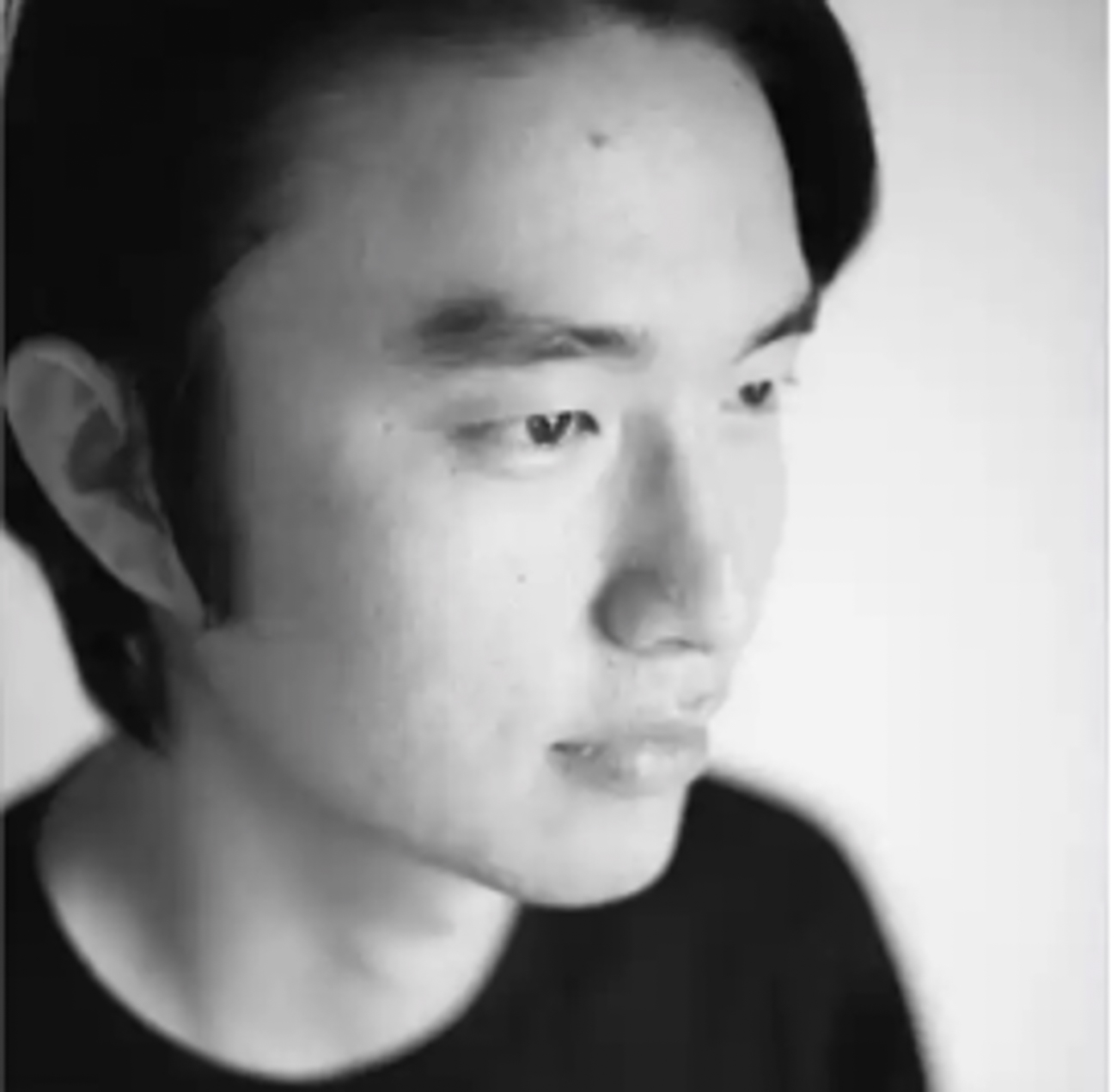
Yuki Yoshioka, Design Division, DENSO Corporation
He studied media art and design at Tama Art University. Afterward, he moved to Berlin, Germany, where he encountered works associated with FAB culture and what is known as bioart. While working as a research fellow with the artistic research framework BCL and at Waseda University’s Faculty of Science and Engineering, he collaborated with researchers in the field of biology to create artworks based on the concept of speculative design. In 2015, he organized a special exhibition titled “Ghost in the Cell: The Spirit Within the Cell” at the 21st Century Museum of Contemporary Art, Kanazawa, showcasing bio-artistic creations. Currently, he serves as an in-house artist at a company, leading projects that apply artistic thinking and communicating them to society.
‘The question we should be asking is, “Who will this technology make happy?” Having that kind of vision is essential. If we can strike a balance between being technology-driven and vision-driven, the company will become even stronger.”
Reframing a company’s technologies and expertise through the lens of vision can generate new business ideas. The TGDA project could potentially serve as a role model for how small and mid-sized companies can redefine the value of their technologies.
DENSO’s corporate activities are guided by two core visions: to “keep economic activity going” and to “respond to diverse values and forms of happiness”. TGDA is a project that addresses the values and well-being of craftspeople and manufacturing professionals.
TGDA’s digital archives aim to provide future generations with inspiration and options for action. Even if traditional crafts and techniques are not passed down and eventually fade away, the archived data could enable individuals in the future to reinterpret and repurpose them.
These practices, sparked by the archive, have the potential to give rise to new cultural expressions. TGDA continues its efforts with the goal of creating a world where culture born from these archives can give back to the artisans themselves.
The TGDA project is also featured on the official website of DENSO’s Design Division.
TGDA Project (DENSO Design Division Website) (Japanese only)
Overview
Client: DENSO Corporation
Project Name: TGDA – TECHNO GRAPHICAL DATA ARCHIVE
Project Period: March 2023 –
Project structure
- DENSO Corporation
Yuki Yoshioka - FabCafe / Loftwork
Project Management: Kaede Osumi
Creative Direction: Daiki Kanaoka, Kei Iwakura, Yuto Morita
Technical Direction: Tomomi Ito, Naoya Tsuchida
Production: Lisa Hiraga - Production Partners
Research Design: Hitoshi Iwasawa (Iwasawa Brothers)
Scanning & Technical Direction: Junichiro Horikawa
Web Creative Direction & Photography: Lasse Kusk
Web Design: NOZOMI AKUTSU - Special thanks for scanning collaboration:
Hiroshi Murase (4th Generation Chairman and Shibori Design Artisan, Suzusan Co., Ltd., Arimatsu-Narumi Shibori Planning and Manufacturing)
Kaei Hayakawa (Arashi Shibori Textile Artist)
Written by: Hayato Inui
Edited by: Yutaro Gokan
Translated by: Eri Nakagawa
-
Kaede Osumi
FabCafe Creative Director
While studying at a fashion vocational school, she developed an interest in fashion as a medium. She later pursued studies in the Department of Information Design at Tama Art University, where she explored clothing in relation to specific environments and cultures, as well as the nature of communities that emerge within them. She has been involved in planning and operations for various fashion brands, media communities, and galleries, and also participated as an intern at NEWVIEW SCHOOL.
With a desire to question norms and view things from multiple perspectives, she joined FabCafe to help create new forms of community and value where diverse individuals can make the most of their unique qualities. She is particularly interested in events centered around craftsmanship and cross-cultural exchange.
While studying at a fashion vocational school, she developed an interest in fashion as a medium. She later pursued studies in the Department of Information Design at Tama Art University, where she explored clothing in relation to specific environments and cultures, as well as the nature of communities that emerge within them. She has been involved in planning and operations for various fashion brands, media communities, and galleries, and also participated as an intern at NEWVIEW SCHOOL.
With a desire to question norms and view things from multiple perspectives, she joined FabCafe to help create new forms of community and value where diverse individuals can make the most of their unique qualities. She is particularly interested in events centered around craftsmanship and cross-cultural exchange.
-
Daiki Kanaoka
FabCafe Tokyo CTO and COO
After studying architecture at the University of Manchester, Daiki joined Loftwork and FabCafe in 2015. Utilizing his knowledge of digital fabrication and extensive overseas networks, he has been involved in a wide range of projects, including launching the FabCafe brand onto the global stage and frequent collaborations with both overseas and domestic creators. He is currently serving as the CTO and COO of FabCafe Tokyo.
After studying architecture at the University of Manchester, Daiki joined Loftwork and FabCafe in 2015. Utilizing his knowledge of digital fabrication and extensive overseas networks, he has been involved in a wide range of projects, including launching the FabCafe brand onto the global stage and frequent collaborations with both overseas and domestic creators. He is currently serving as the CTO and COO of FabCafe Tokyo.
-
Kei Iwakura
FabCafe Tokyo Vice Manager
She graduated from the School of Global Japanese Studies at Meiji University. After studying intercultural education during a six-month exchange program in the United States, she joined a major apparel materials manufacturer. While operating machinery at a factory, she realized how the design of buttons—such as their placement and color—could influence human behavior, which sparked her interest in design. She joined Loftwork in 2018.
Passionate about sharing the unique appeal of Japan with a global audience, she is currently studying English and Chinese. She loves cats, radio, and fashion.
She graduated from the School of Global Japanese Studies at Meiji University. After studying intercultural education during a six-month exchange program in the United States, she joined a major apparel materials manufacturer. While operating machinery at a factory, she realized how the design of buttons—such as their placement and color—could influence human behavior, which sparked her interest in design. She joined Loftwork in 2018.
Passionate about sharing the unique appeal of Japan with a global audience, she is currently studying English and Chinese. She loves cats, radio, and fashion.
-
Tomomi Ito
Loftwork Technical Director
After graduating from the Department of Moving Images and Performing Arts at Tama Art University, she worked in planning and design for sales promotion tools and novelty items. Through her involvement in updating websites as part of her duties, she developed an interest in coding and transitioned to a freelance web production agency as a front-end developer. There, she worked on brand sites for major cosmetics companies and campaign sites for apparel brands. Experiencing a lifestyle of constant late-night overtime, she became interested in structured production frameworks based on PMBOK, which led her to join Loftwork in 2018.
Her hobbies include cooking, reading, and appreciating art. On her days off, she enjoys visiting galleries and museums, and she never misses preparing homemade miso in winter and pickled plums in summer.
After graduating from the Department of Moving Images and Performing Arts at Tama Art University, she worked in planning and design for sales promotion tools and novelty items. Through her involvement in updating websites as part of her duties, she developed an interest in coding and transitioned to a freelance web production agency as a front-end developer. There, she worked on brand sites for major cosmetics companies and campaign sites for apparel brands. Experiencing a lifestyle of constant late-night overtime, she became interested in structured production frameworks based on PMBOK, which led her to join Loftwork in 2018.
Her hobbies include cooking, reading, and appreciating art. On her days off, she enjoys visiting galleries and museums, and she never misses preparing homemade miso in winter and pickled plums in summer.
-
Lisa Hiraga
Loftwork Producer
Having spent her childhood in the UK and Singapore and growing up with a younger sister with Down syndrome, she has embraced the realization of “a society where everyone can shine” as her life mission. After graduating from university, she worked at an advertising agency before transitioning to hands-on caregiving at a social welfare facility. There, she began to question the binary division between the supporter and the supported, and came to believe that care should not be limited to a specific group but be open to society as a whole. She also reaffirmed the importance of mental health.
In 2024, she launched moya studio, an incense brand using traditional Japanese woods, starting with a debut in New York and expanding both domestically and internationally. She joined Loftwork with the aim of creating new social contexts through co-creation and tackling complex challenges.
She holds a degree from Keio University SFC.Having spent her childhood in the UK and Singapore and growing up with a younger sister with Down syndrome, she has embraced the realization of “a society where everyone can shine” as her life mission. After graduating from university, she worked at an advertising agency before transitioning to hands-on caregiving at a social welfare facility. There, she began to question the binary division between the supporter and the supported, and came to believe that care should not be limited to a specific group but be open to society as a whole. She also reaffirmed the importance of mental health.
In 2024, she launched moya studio, an incense brand using traditional Japanese woods, starting with a debut in New York and expanding both domestically and internationally. She joined Loftwork with the aim of creating new social contexts through co-creation and tackling complex challenges.
She holds a degree from Keio University SFC.
-
FabCafe Global Editorial Team
This articles is edited by FabCafe Global.
Please feel free to share your thoughts and opinions on this article with us.
→ Contact usThis articles is edited by FabCafe Global.
Please feel free to share your thoughts and opinions on this article with us.
→ Contact us

